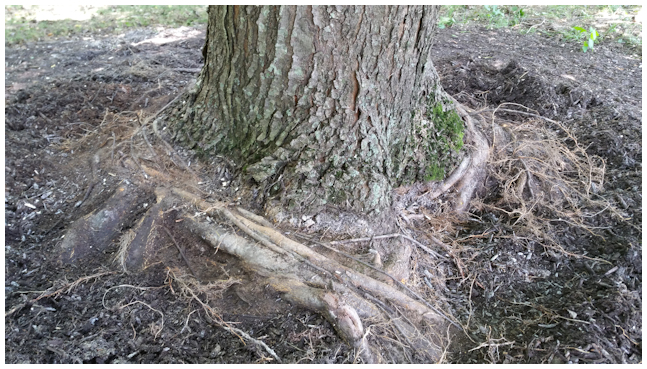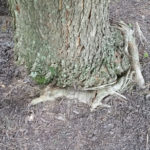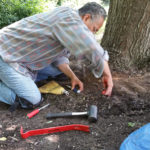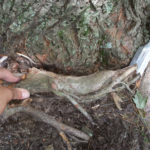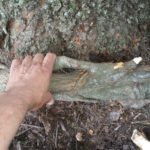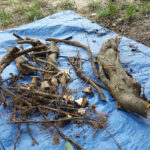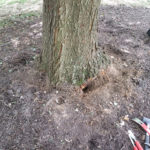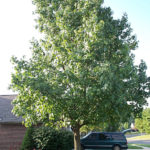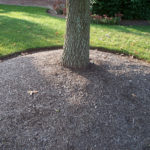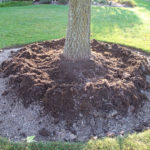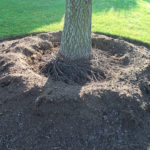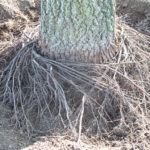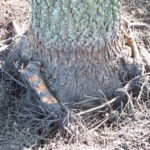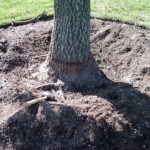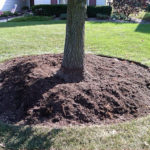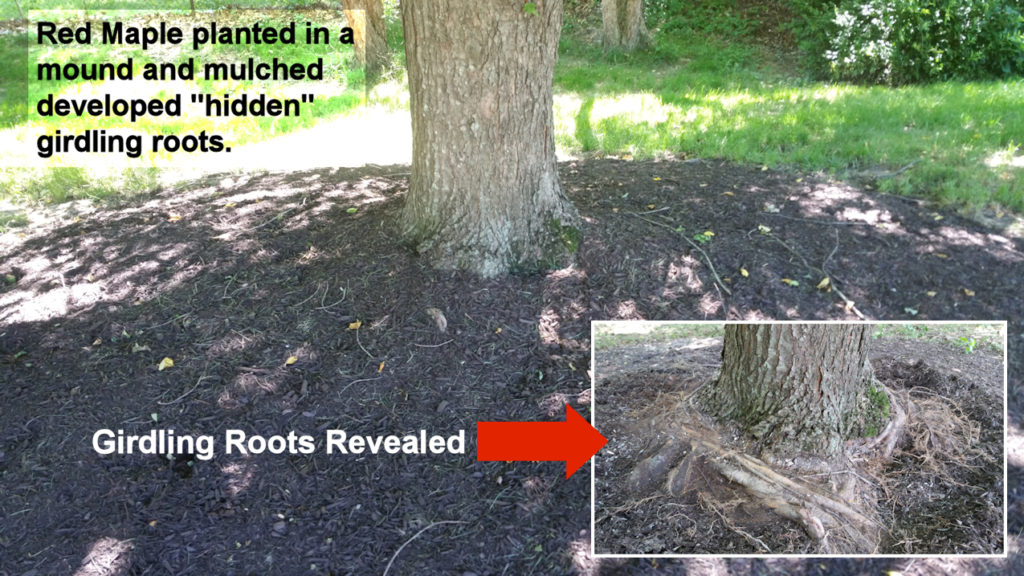
This maturing Red Maple has girdling roots that developed over the years and were hidden by years of mulching.
Of the many ways to kill a tree in the landscape, Girdling Roots ranks high among them, along with poor irrigation, planting too deep (which often causes girdling roots), and mechanical injuries. But just what are girdling roots and where do they come from? [Note: Most photos and images have an enlarged view if you click on them.]
SUFFOCATION – Girdling roots can result from roots that develop as a response when oxygen availability has been reduced below necessary levels. This can happen when a plant has been planted too deeply, or by the addition of too much top soil (i.e. grade change) or from improper mulching (i.e. too deep; “volcanic” mulching), or soil compaction, etc.
CONTAINMENT – Girdling roots are common with container-grown plants. If they remain in the container too long their roots will be deflected by the container walls, causing them to grow in a circular pattern. Even a ball & burlap tree can develop girdling roots if left in this packaging for too long. Another type of containment may be the improper use of edging materials.
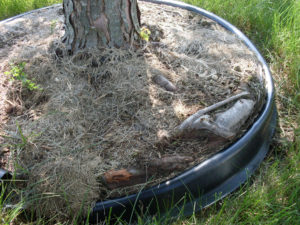
Edging was not adjusted periodically to allow for the expansion of roots in this tree causing the roots to encircle the edging barrier.
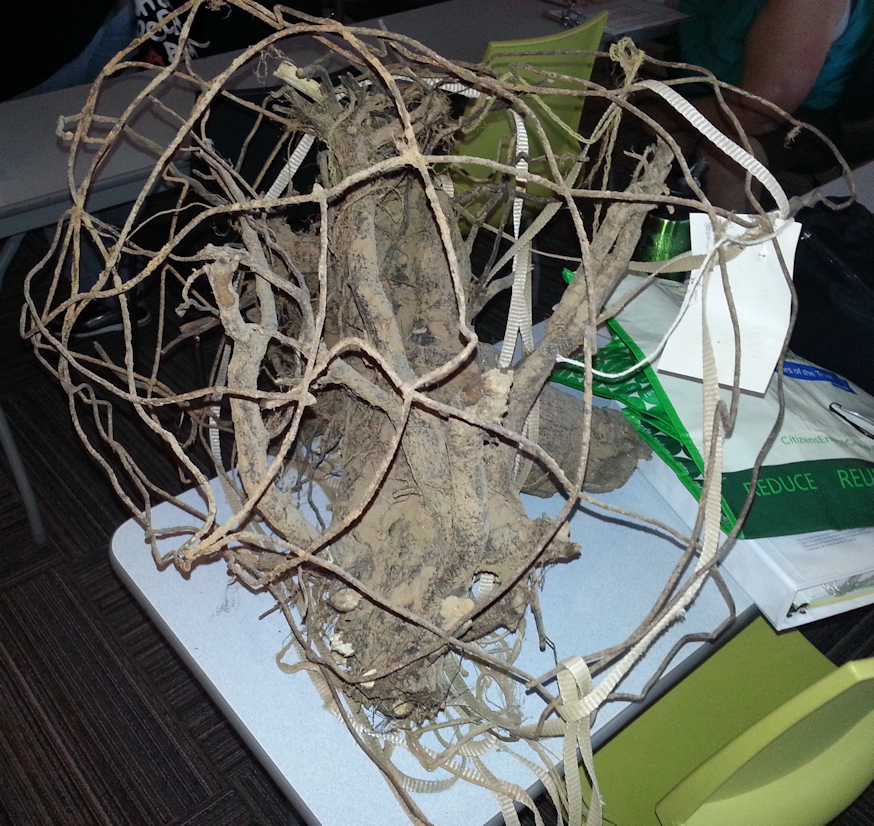
Wire basket-bound roots lead to the demise of this ball ‘n burlap tree. (Sample photoed during an Indiana Tree Stewards training session conducted by Carrie Tauscher (IDNR/CUF)
Whatever the reason, girdling roots encircle or cross-over the trunk/root flare of a plant rather than radiating outward (like a bicycle’s wheel spokes). Over time the trunk and girdling roots continue to expand in diameter with each new annual growth ring. Before too long, severe compression to the lower trunk areas create tremendous pressure upon the underlying vascular system (i.e. xylem and phloem). As this constriction builds up the lower trunk stem may begin to swell.
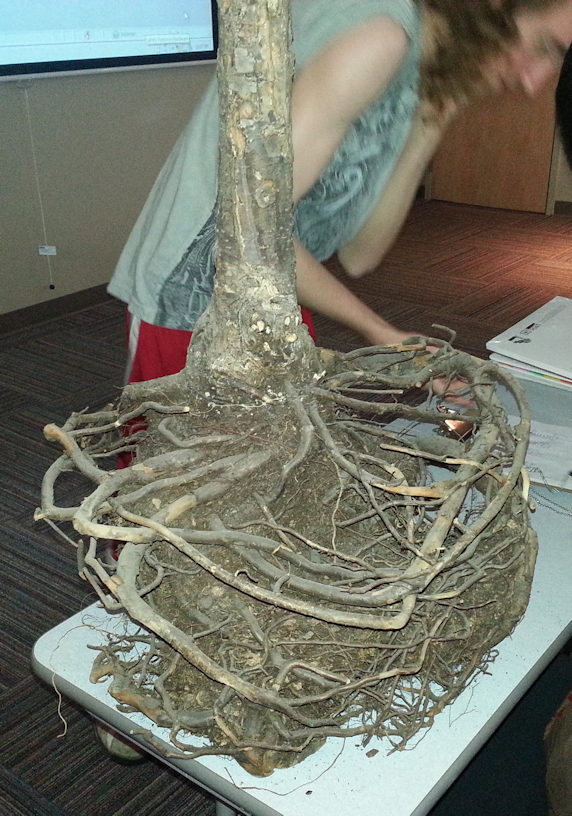
Encircling roots that matured from a containerized tree planting. Instead of being properly pruned off at the time of planting these were left remaining and prevented this tree from establishing a healthy root system. The tree gradually declined and eventually had to be removed. (Sample photoed during an Indiana Tree Stewards training session conducted by Carrie Tauscher (IDNR/CUF)
If left unresolved, the conflicting root(s) may eventually choke and strangle the plant, interrupting the uptake of water and nutrients completely in the girdled zone, which, in turn, leads to:
- plant decline
- attracting wood-destroying organisms
- premature fall color of foliage
- defoliation
- dieback of xylem, cambium, and phloem layers
- loosening and detachment of outer bark
- dieback of twigs, branches, and stems
- high-risk severe dehydration during droughts
- and may eventually kill the entire plant.
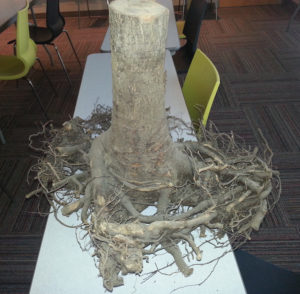
Roots were encouraged to encircle this tree due to improper planting and mulching. The girdling roots eventually necessitated the removal of this tree. (Sample photoed during an Indiana Tree Stewards training session conducted by Carrie Tauscher (IDNR/CUF)
Girdling roots are called “the silent killer” for a reason. No one appears to take notice of the deadly damage they do until it is too late… a tree declines severely and then dies. Although girdling roots can occur naturally, many times they result from improper planting and poor cultural practices. Not surprisingly, MOST of these girdling root problems in our landscapes could have been avoided if good management practices were in place.
PREVENTION and ANNUAL MAINTENANCE
The best prevention of girdling roots is to plant trees properly from the start and then annually inspect them before laying down new mulch and avoiding volcanic mulching.
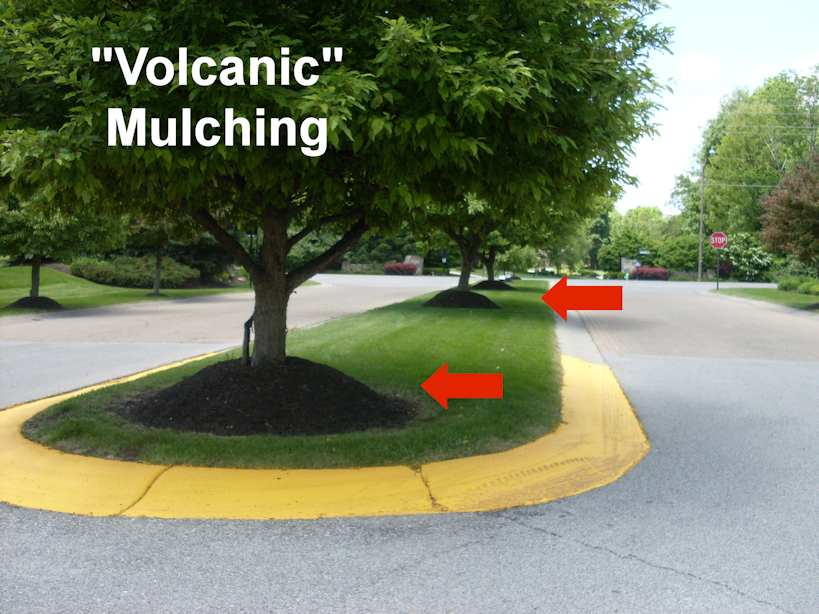
Ornamental crabapples that were meant to adorn this community’s common entrance were improperly mulched.
If a tree has been on site for a while and has existing girdling roots, some of these may be removed using hand-pruners without causing significant harm to the tree. On the other hand, severely girdled trees usually require the skills, knowledge and an experienced of a Certified Arborist because not all girdling roots can be safely removed, nor should they be. There are instances where a tree becomes dependent on the very girdling root that is killing it because the root has matured and grown to such an extent that it actually sustains a portion of the tree with vital water and nutrients. To remove such a root would only accelerate the demise of an already doomed tree. If such a tree does not pose a risk to humans or property, it may be best to let it live out its life, serving as habitat for other creatures, until it finally falls down or becomes an eyesore that needs removal.
| Here is a sequence of field photos from a typical girdling root removal job performed by Jeff Harris (2017). Click images to enlarge: | |
The AIR-SPADE
Although simple girdling root operations may not require much excavation to access them, most jobs are not so easy. The best method for clearing away soil to inspect for girdling roots is through the use of an air-spade (a.k.a. air-knife). Unlike using a shovel, this is a professional air excavation tool that utilizes a highly compressed jet of air to remove soil without causing any serious harm to a tree’s root system. With the soil removed, the root system is revealed and girdling roots, if present, are exposed allowing for better assessment. A trained arborist can then remove these, wherever possible, so long as the removal(s) are not detrimental to the tree or otherwise accelerate a tree’s decline. Here’s a video that features how the AirSpade works:
Types of Sanitizing Solutions for Disinfecting Pruning Tools & Equipment (Follow specific label directions, if applicable)
- Household Disinfectants (e.g. Lysol, etc.): full strength
- Household bleach (e.g. Clorox, etc.): up to 25% solution (e.g. 1 part bleach + 3 parts water)
- Rubbing alcohol (70% isopropyl): 50% solution (e,g, 1 part alcohol + 1 part water)
- Pine oil cleaner (e.g. Pine-Sol, etc.): 25% solution (e,g. 1 part cleaner + 3 parts water)
More Information on Girdling Roots
- A Practioner’s Guide to Stem Girdling Roots of Trees – (University of Minnesota) Impacts on Trees, Symptomology, and Prevention
- Stem Girdling Roots – The Underground Epidemic Killing Our Trees (University of Minnesota)
- Girdling Roots – (Missouri Botanical Gardens) The causal factors may be genetic or cultural. At the end of this article is a list of trees that may be more prone to stem girdling roots. Cultural practices that may cause girdling include poor growing practices or poor planting techniques.
- Stem Girdling Root Removal – (University of Florida) Roots that girdle the stem (stem girdling roots) can be removed. There are many examples of this discussed with photos in this article.
ACKNOWLEDGEMENTS
A special THANK YOU to a few industry professionals who gave me early exposure and opportunities to learn about girdling roots and those who enabled me to gain experience in using the AirSpade and insights and training in girdling root removals: Phil Ping , Mike Webster and Aaron Wimmer (Ping’s Tree Service/ISA Certified Arborists , Indianapolis, IN). Additional resources: Pam Louks (formerly IDNR/CUF Programs Coordinator), Gary R. Johnson (University of Minnesota Extension Professor), Lindsey Purcell (Purdue University, Urban Forest Specialist, formerly Indy Parks City Forester), Carrie Tauscher (IDNR/CUF Programs Coordinator), Andrew Hart (former Director of Urban Forestry, Keep Indianapolis Beautiful), Nate Faris (Director of Community Forestry KIB) and Jerome Delbridge (former Coordinator of KIB’s NeighborWoods program), Jon Xanders (Owner, Xanderbuilt Tree Care, ISA Certified Arborist), with additional Supersonic Air Knife information from Dave Leonard (Owner of Dave Leonard Tree Specialists, Versailles, KY).

